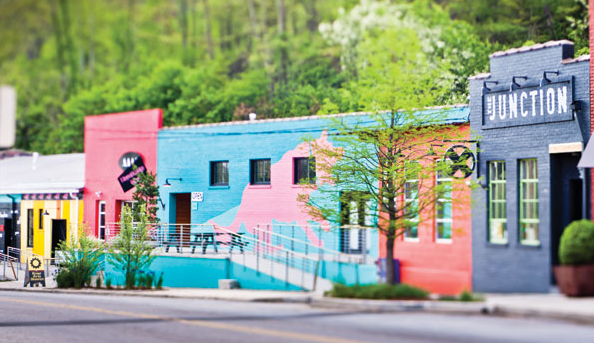The City of Asheville will kick off the form-based code process for the River Arts District with a community meeting at 6 p.m. June 17 at the Grant Southside Center, 285 Livingston Street.
Since the adoption of its 2025 Comprehensive Plan, the City of Asheville has recognized a need to grow more efficiently and sustainably. That vision requires higher densities and multi-story structures along corridors like Lyman Street and Riverside Drive that have sufficient roadway infrastructure and lot sizes to handle new growth and design standards that reflect community goals. With that recognition the goal is to move towards a regulatory framework for growth and development that promotes a walkable, pedestrian-friendly street environment desired by residents, visitors and many business owners.
The City Council funded this project because a form-based code is an increasingly popular tool being implemented in many cities that produces clear expectations for new development. With form-based code, developers, property owners and the community know in advance what the community wants and will accept.
This is the second form-based code project in the City; the Haywood Road Corridor form-based code was adopted by City Council in September 2014.
Form-based codes have been discussed for a number of years in Asheville as a planning tool that can replace traditional zoning with its focus on land uses, building setbacks and heights. Its goal is to provide effective development tools to enliven streetscapes and make neighborhoods more walkable and economically viable.
This is an important tradeoff where additional density is anticipated and desired. In the City’s current zoning ordinance, form-based “type” codes are not entirely new. Some zoning districts adopted over the past ten years, such as Urban Village and Urban Place zones, are examples of a “hybrid” code, incorporating form-based elements governing placement and development for new buildings along with land uses and other parcel regulations. This emerging hybrid code approach is best represented by the recently adopted Downtown Master Plan and the zoning code created to integrate the plan with zoning requirements for the Central Business District.
“After the success of the Haywood Road form-based code, City Council and staff were interested in pursuing this tool in an area that will be seeing a great deal of redevelopment in the years to come. The River Arts District was specifically selected because other investments in the area make it the right time to pin down how buildings will relate to the street, especially the new Riverway,” said Alan Glines, Interim Director of the Planning and Urban Design Department.
The primary focus of the River Arts District form-based code will to help create welcoming pedestrian-oriented public spaces while encouraging new buildings in scale with the local community and neighborhood. By requiring form-based standards, new development in the River Arts District will complement existing buildings while providing increased density and better pedestrian connections.
“I have had my business, Joe Ransmeier Woodworking, here in the River Arts District for over 20 years now,” said River Arts District business owner Joe Ransmeier. “I’m on the board of directors of the River Arts District Artists and volunteered to represent them in meetings with the form-based code committee this year because we want to have input into this process.”
The River Arts District Form-Based Code process is expected to continue through 2016, with a draft form based code being presented in early Spring 2016.
The City of Asheville has secured the professional assistance of the Code Studio planning firm from Austin, Texas; a national leader in the creation of form based codes for this project. The Code Studio team was selected after a review of proposals from planning consultants across the country. As the project progresses, other team members will step in and provide expertise in transportation and parking solutions (Nelson-Nygaard Associates), building and streetscape design (Third Coast Design Studio) and economic analysis and viability (Noell Consulting Group).
At this first public meeting for the Form-Based Code project on June 17 the principal of Code Studio, Lee Einsweiler, will present the form-based code process and explain how the community will be involved in the River Arts District study. For more information, email Sasha Vrtunski, lead planner for this project, at svrtunski@ashevillenc.gov or call 828-259-5560.
Also you can keep up with the project online at rad-code-studio.com or on Facebook at facebook.com/radformbasedcode.
